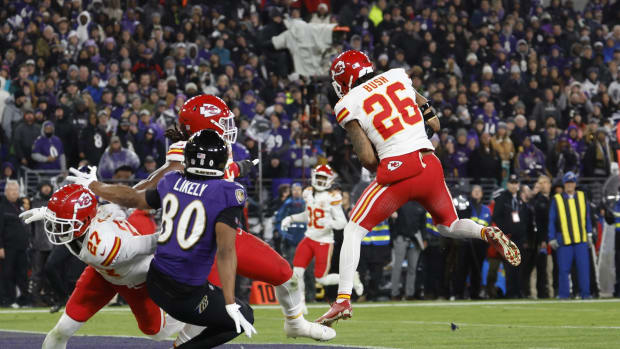
The Ravens’ Run Game: Ground Down
The Ravens reinvested in Leach, but Baltimore has generated little going straight ahead against defenses. (Jason Bridge/USA TODAY Sports)
Who are these Baltimore Ravens? Not the franchise that powered its way through the AFC North for a decade. And not the group that discovered a balanced offense in time to win a Super Bowl in February.
Take Baltimore’s final drive of Sunday’s 19-16 loss at Pittsburgh: With 10 minutes remaining, down 16-9, the Ravens went shotgun no-huddle and threw the ball, tossing in several draw plays after running to no effect in the first half (30 yards on nine carries against a 22nd-ranked run defense). In the end it was spread formations and deception—this from a team that went back to the well and re-signed big-bodied fullback Vonta Leach for $3.75 million in August.
It worked. The sudden change in strategy saw Baltimore move 73 yards downfield (a quarter of their total offense on the day), tying the game with two minutes remaining. Yet Ben Roethlisberger found enough time to drive Pittsburgh into range for a last-second field goal that gave the Steelers a 19-16 win, raising Pittsburgh to 2-4 and dropping the Ravens to 3-4.
Baltimore finally sustained some offensive success only after becoming one-dimensional in scheme, failing earlier to correct the blocking woes with their bread-and-butter Leach-Ray Rice lead plays, which had been a point of emphasis this week in practice. It used to be that the Ravens’ willingness to run a no-huddle offense was viewed as an indication of the coaching staff’s growing trust in quarterback Joe Flacco. Now it’s an indictment of an offensive line that can’t run-block it’s way out of a paper bag, much less Heinz Field or the division.
What gives?
“I don’t feel like we’ve gotten enough yards per carry for our coaches to have confidence in us in those situations, and that’s on us,” says guard Kelechi Osemele. “That’s on the offensive line, and we need to improve and get back to where we were last year where we got in situations like that and were able to run the ball. We have to improve to get that trust back.”
Flacco has has seen his blocking fail him in the run game and pass protection alike. He’s suffering more sacks (2.9 per game) than at any other point in his career. (Vincent Pugliese/Getty Images)
It was only 10 months ago the Ravens handled a very similar situation entirely different. Down 35-28 with seven minutes remaining against the Broncos in the divisional playoffs, John Harbaugh stuck his quarterback under center, sent tight ends Ed Dickson and Dennis Pitta onto the field and told his team to chew up yards and clock in the manner that the Ravens have for a decade. They ran four tailback carries in the first six plays of that drive. The idea: score a touchdown, keep the ball out of Peyton Manning’s hands and head to overtime.
It was working until an Osemele false start stalled the drive in Broncos territory and a Flacco toss to Pitta failed on fourth down. Things were looking grim after that, until Flacco’s last-minute deep ball to Jacoby Jones cleared Broncos safety Rahim Moore’s fingers.
Fast-forward 10 months to Sunday at Heinz Field. The Ravens came to Pittsburgh averaging 2.7 yards per carry, with 19 sacks allowed by a retooled offensive line. Juan Castillo, the former Eagles defensive coordinator, is the run-game coordinator for offensive coordinator Jim Caldwell, and Castillo’s zone-blocking preference has come under scrutiny as the team consistently fails to produce with it.
Dallas Clark and the Ravens may have to resort more to the spread attack if they’re going to get their hands on a playoff berth. (Gene J. Puskar/AP)
That’s not to say the Ravens didn’t run zone or have success with it before Castillo, or that zone is the only thing they’re running now. Truthfully, they’re not running anywhere but backwards. Only the Jaguars have a poorer run-blocking grade from Pro Football Focus this year. Rice has a season-long run of 14 yards, and Baltimore has eclipsed 100 yards rushing only once this season despite boasting Pro Bowlers in Leach and Rice and an emerging talent in tailback Bernard Pierce.
The problem is not one person,” Leach says. “There’s a lot of stuff we’ve got to get better at. We always seem like we have a breakdown, whether it’s a person on the backside or the frontside.”
Circumstances on all sides are complicated. Pitta is out for the season with a hip injury. There’s the retirement of center Matt Birk and the elevation of Gino Gradkowski, whose run blocking isn’t near as bad as his pass protection. Then there’s right guard Marshal Yanda, coming back from shoulder surgery and still working his way back into Pro Bowl shape. Eugene Monroe is still learning the offense after he was acquired from the Jaguars to replace a struggling Bryant McKinnie on Oct. 1. Yet the biggest concern has to be the play of Osemele, who on Sunday rarely won the pad-level fight and watched Steelers safety Troy Polamalu and other smaller men cross his face with impunity on their way to the ball. Osemele doesn’t appear to be finishing blocks or moving as quickly as he did last season, and with good reason: The second-year guard expects to have back surgery in the offseason.
“I’m not 100%, and I wont be until surgery after the season, until they fix the disk,” he said. “But I manage it, and treat it every day to treat the symptoms. With this issue degrading, it’s going to take time to heal. And it’s not going to heal during the season; this is a full-contact sport. But I can’t make excuses, I’ve just got to continue to get better.”
The Ravens don’t have great options behind Osemele. If he’s benched or unable to play, A.Q. Shipley is the next man up. The 2009 seventh-rounder was serviceable in backup duty last season, but he’s also the backup to the struggling Gradkowski. If shotgun draws and sweeps become the only effective way for the Ravens to run the ball—change-of-pace plays in a pass-heavy offense—that’s fine as long as Flacco (eight touchdowns, eight interceptions) can carry the load and handle the punishment.
Despite the records, Ravens-Steelers didn't lack for passion or hard hits, especially from the reinvigorated Troy Polamalu. (Don Wright/AP)
“We tried to spread them out and run the ball a little bit tonight,” said Dickson, who played in Chip Kelly’s offense at Oregon. “It’s our mentality to run the ball. We’re known for running the ball, so we’ll do whatever it takes. I come from an offense like that, and everybody thinks it’s kind of soft but it’s not. You spread them out and then you go up the gut.”
If that’s the direction the Ravens are headed, they’ve got a bye week to iron out the kinks, then a visit to Cleveland and after that a home game versus the division-leading Bengals. Yet it doesn’t sound like the Ravens are ready to give up on their investment in the power run game, with Leach as a lead blocker, or limit themselves to the shotgun. Castillo believes time is on their side: “Its still early in the season,” he said. “We’re going to fix it.”








































